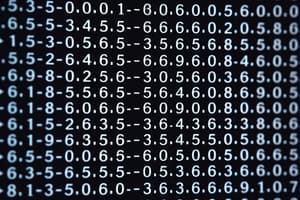Podcast
Questions and Answers
What type of test is the second periodical examination?
What type of test is the second periodical examination?
- Multiple Choice (correct)
- Essay
- Oral examination
- Problem Solving
The passing score for the exam is 40 points.
The passing score for the exam is 40 points.
False (B)
Module 13 focuses on determining the sample size that estimates the population ________ and population proportion.
Module 13 focuses on determining the sample size that estimates the population ________ and population proportion.
mean
Which module covers illustrating null and alternative hypotheses?
Which module covers illustrating null and alternative hypotheses?
Module 19 focuses on hypothesis testing for population proportions.
Module 19 focuses on hypothesis testing for population proportions.
How many items are there in the test?
How many items are there in the test?
Module 17 & 18 focuses on Computing for the Point Estimate and Confidence Interval of the Population Proportion
Module 17 & 18 focuses on Computing for the Point Estimate and Confidence Interval of the Population Proportion
Module 20 focuses on hypothesis testing for the population what?
Module 20 focuses on hypothesis testing for the population what?
The second periodical examination is a statistics and algebra examination.
The second periodical examination is a statistics and algebra examination.
Module 16 discusses ________ types of errors.
Module 16 discusses ________ types of errors.
Match the module number with the correct topic:
Match the module number with the correct topic:
What is the course code for the Statistics and Probability examination?
What is the course code for the Statistics and Probability examination?
There are 60 items in the test for 50 points.
There are 60 items in the test for 50 points.
Which module introduces the topic of identifying the appropriate test statistic?
Which module introduces the topic of identifying the appropriate test statistic?
The second periodical examination is on ________ and Probability.
The second periodical examination is on ________ and Probability.
What type of test has been announced?
What type of test has been announced?
You need to bring a ________ for your own convenience.
You need to bring a ________ for your own convenience.
The exam is scheduled for next monday.
The exam is scheduled for next monday.
Which module covers determining the sample size that estimates the population?
Which module covers determining the sample size that estimates the population?
Flashcards
Point Estimate
Point Estimate
Estimating a single value for a population parameter.
Confidence Interval
Confidence Interval
Range of values likely to contain the population parameter.
Confidence Level
Confidence Level
The probability that the confidence interval contains the true population parameter.
Margin of Error
Margin of Error
Signup and view all the flashcards
Hypothesis
Hypothesis
Signup and view all the flashcards
Null Hypothesis
Null Hypothesis
Signup and view all the flashcards
Alternative hypothesis
Alternative hypothesis
Signup and view all the flashcards
Type I Error
Type I Error
Signup and view all the flashcards
Type II Error
Type II Error
Signup and view all the flashcards
Rejection Region
Rejection Region
Signup and view all the flashcards
Test Statistic
Test Statistic
Signup and view all the flashcards
Study Notes
Vectors
- A vector represents an ordered list of numbers.
- A vector of size n is generally represented as a column vector with elements x₁, x₂, up to xₙ.
- Vectors can be represented as lists or NumPy arrays in Python.
- Vectors must be the same size to be added. Components are added element-wise.
- Scalar multiplication involves multiplying each vector element by the scalar value.
Matrices
- A matrix represents a rectangular array of numbers, organized into rows and columns.
- A matrix of size $m \times n$ has elements aᵢⱼ, where i is the row number and j is the column number.
- Matrices can be represented using NumPy arrays in Python.
Matrix Operations
- Matrix addition is performed element-wise on matrices of the same size. $$ A + B = \begin{bmatrix} a_{11} + b_{11} & a_{12} + b_{12} & \cdots & a_{1n} + b_{1n} \ a_{21} + b_{21} & a_{22} + b_{22} & \cdots & a_{2n} + b_{2n} \ \vdots & \vdots & \ddots & \vdots \ a_{m1} + b_{m1} & a_{m2} + b_{m2} & \cdots & a_{mn} + b_{mn} \end{bmatrix} $$
- Scalar multiplication involves multiplying each matrix element by the scalar value. $$ \alpha A = \begin{bmatrix} \alpha a_{11} & \alpha a_{12} & \cdots & \alpha a_{1n} \ \alpha a_{21} & \alpha a_{22} & \cdots & \alpha a_{2n} \ \vdots & \vdots & \ddots & \vdots \ \alpha a_{m1} & \alpha a_{m2} & \cdots & \alpha a_{mn} \end{bmatrix} $$
- Matrix multiplication:
- Two matrices A and B can be multiplied only if the number of columns in A equals the number of rows in B.
- For an $m \times n$ matrix A and an $n \times p$ matrix B, the resulting matrix C ($C = AB$) has dimensions $m \times p$.
- The element $c_{ij}$ of matrix C is computed as: $$ c_{ij} = \sum_{k=1}^{n} a_{ik}b_{kj} $$
Studying That Suits You
Use AI to generate personalized quizzes and flashcards to suit your learning preferences.




